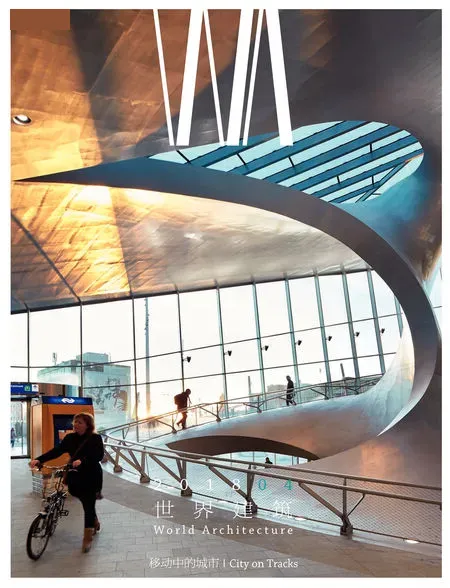柏林中央火车站,柏林,德国
建筑设计:冯-格康,玛格及合伙人建筑师事务所
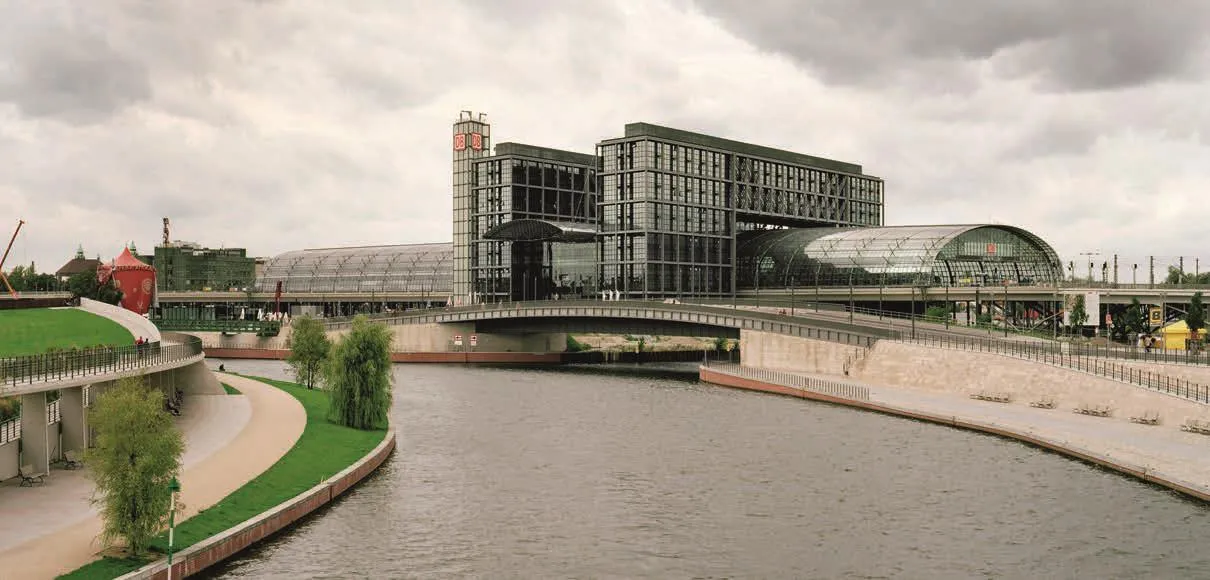
柏林中央火车站是欧洲最大的包括远程、区域和市内交通在内的枢纽型火车站,建在莱尔特老火车站的原址上,位于柏林市的动物园地区。新的城际特快地下层南北线与东西线弧形铁轨在新火车站汇聚相连。此外,双向的区域列车以及一条地下南北线路也途径此站。这条南北线位于地下15m深的隧道中,横穿施普利河与动物园地区。这是一座拥有8站台远程线路、4站台区域线路以及U5号地铁线的全新火车站。东西线的标高被抬高了10m,并与之前的铁轨线路弧度吻合。四座新建铁路桥上排布了4条远程线路与两条城市铁路线。目前,火车站每日车次达1800次,日均客流量已达到30万人/次。由于临近施普利河湾处的行政区,中央火车站也被赋予了更多的内涵。从城市角度,它同时服务于北部的柏林莫阿比特区。
柏林中央火车站设计的核心思想是在城市环境中凸显现存铁路线的走向。巨大的轻质玻璃屋顶与两栋与之交叉的办公楼体量作为建筑语言诠释了这一设计原则。
火车站通过3个层面组织交通功能:
地下二层:南北向远程线路与区域列车;U5号地铁
地面层:市内公共交通;旅客私人交通(连接市政道路、临时停车场);自行车与行人交通;游客交通(大巴、游船)
地上一层:远程线路与区域列车;城市轨道交通线路S3、S5、S6、S7、S9
柏林中央火车站总建筑面积达17.5万m2,包括1.5万m2的商业餐饮、5万m2办公、5500m2铁路管理用房以及2.1万m2的交通面积。站台区域共计3.2万m2,此外还有2.5万m2停车场。
玻璃大厅
东西向长达430m的站台大厅被一片321m长的大型轻质玻璃屋顶覆盖。两条建筑体量在此交汇,地下铁路线的南北走向定义了两栋建筑体的位置与排列方向。从城市规划与建筑角度出发,这些被命名为“拱楼”的体量与火车站的玻璃大厅共同组成了一个整体。45m宽、159m长的南北向车站大厅同样位于两栋办公楼之间,并被一片轻巧的玻璃拱顶覆盖。玻璃大厅在朝向莫阿比特区与行政区两个方向都呈现出友好的迎客姿态,因此也加强了政府行政区与市民街区之间的联系。经由南北向的玻璃入口大厅可以进入拱形办公楼。玻璃拱顶由4.7m高的鱼型梁支撑,坐落在“拱楼”的承重结构上。
东西站台大厅玻璃顶结构
地上弧形城市铁路桥沿东西方向伸展,容纳了6条铁轨与3个站台,结构上采用了无柱的三向拱形轻质壳结构。拱梁在纵向每隔1.5~1.7m排列,与纵向梁形成了近乎方形的结构网格单元。每个方形单元在对角线上用钢索加固并覆盖玻璃。拱形、纵向梁与斜向钢索共同构成了一个完整的壳式结构。
气候策略方面主要考虑不同形式的自然通风。室内热空气在玻璃拱顶的帮助下迅速上升到屋顶。新鲜的冷空气则从檐口位置导入室内空间,废气通过屋顶开窗排出。为了实现优化的室内气候,东西向玻璃屋顶全部采用了防紫外线单层玻璃。在占屋顶面积8.4%的最易传热的面积布置了光伏电板,也为站台区域提供了额外的遮阳措施。
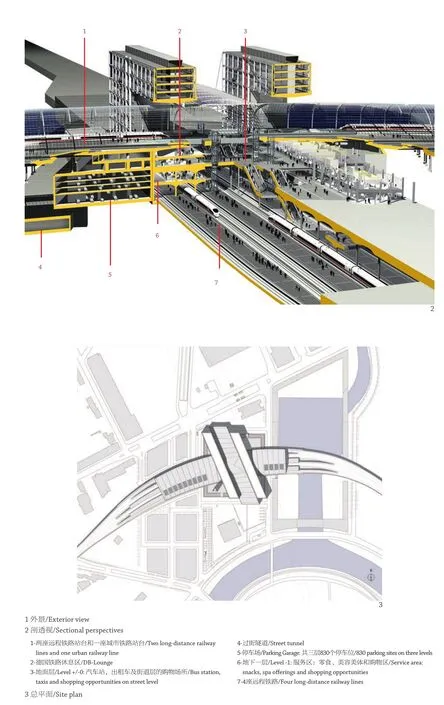
站台大厅与基座建筑
十字形的火车站坐落在一个基座建筑上,后者同时联系了两座主要的办公楼。矩形的基座可以从四面经由楼梯到达,提供了标高4.43m上的开放公共空间,与交通区域明确隔离。从城市规划方面讲,基座中容纳的功能恰好促成了十字形大厅与周边街区的联系。同时,这一基座也为火车站综合体提供了进一步开发利用的可能,推动城区发展。服务与供货区位于基座的东西侧。大面积的商业主要位于西部的地下一层与地面层。铁路相关功能被安置在夹层中,包括柏林中央火车站的出入境管制站。
十字形大厅的中央区域设计了一个巨大的中庭,令日光洒入整个大厅,直达地下层空间,同时也为旅客创造了清晰的方向感。除了多部楼梯,6部观景玻璃电梯也为各个南北向火车站台与东西向城市轨道站台提供了便捷的联系。
拱楼
两栋46m高的建筑横跨东西向铁轨,格网式的幕墙结构映射着玻璃大厅的轻质外观。承重钢结构暴露在幕墙外清晰可见,也因此定义了南北大厅的室内风格。拱楼与车站玻璃大厅共享地面层至四层的幕墙立面,从而共同组成了一个建筑整体。城市轨道上部,办公楼悬挑结构从7~14层跨越87m。悬挑部分的荷载通过通高的外部钢结构承担,进而传递到外部的钢柱与钢梁。
两座拱楼被分为两个独立的功能区域。铁路相关的商业、餐饮与服务设施被安排在低层(地面层与夹层),地下一层为交通空间。10层拱楼中,9层被设计为灵活的办公空间。1.45m的幕墙网格保证了办公单元的灵活划分:小型办公空间与开放型大空间办公皆有可能。不同楼层之间的内部楼梯也创造了未来单个办公单元进行扩展的可能性。
2006年建成后,柏林中央火车站已经成为欧洲最大的火车交通枢纽,以及行政区附近的一个重要交通中心。作为城市、国家与整个欧洲共同发展的象征,中央火车站是往来旅客的一个重要落脚点。同时,这座包含了商业与办公的充满活力的城市综合体整合了周边多样的城市空间,成为柏林心脏发展的内动力。它在落成时还仅仅是一个孤立的个体,现在则成长为城市的基石。在周边逐步进行的城市建设过程中,柏林中央火车站始终保有着地标的力量,使其无可非议地成为了一个首都的独一无二的中央火车站。□
Berlin's new Central Station –Europe's largest train station for long-distance, regional, and local transport – was built on its historical site in the Tiergarten District. At this station the new underground north-south link of the Inter City Express service connects with the west-east line running on a curved railway track. Additionally,suburban railway runs in both directions, as well as an underground line from north to south arrive at this station. The north-south track runs 15 m below ground level in a tunnel, which also passes below the River Spree and the Tiergarten. A train station for long-distance journeys with eight platforms, four platforms for long-distance and regional transport as well as a new train station for the U5 underground line positioned parallel to the eastern platform was realised in this location.The east-west line is elevated 10 m above street level und corresponds to the previous course of the railway tracks. A total of four long-distance railway tracks and two urban train tracks run on four newly constructed urban railway bridges. 1,800 trains call at the station per day and the daily number of passengers has reached 300,000. The train station gains additional significance from its proximity to the government district south of the Spreebogen.Simultaneously it serves the urban district Berlin-Moabit adjoining in the north.
The key design principle of Berlin's Central Station is the clear emphasis of the existing course of the railway tracks in the urban environment.Large, lightweight glass roofs as well as two intersecting office buildings translate this principle with architectural means.
The traffic of the train station is organised on three levels:
Level –2: Long-distance and regional lines from north to south; U5 underground line
Level ±0: Local public transport; individual transport (access road, short-term car park); bicycles and pedestrians; tourist transport (coaches, ships)
Level +1: Long-distance and regional lines on the urban railway track; S3, S5, S6, S7, and S9 urban railway lines.
The new Berlin Central Station comprises a total floor area of 175,000m², with approximately 15,000m² reserved for shops and gastronomy,50,000m² are provided as office space in the arch buildings, 5,500m² serve for operational railway use as well as 21,000m² as circulation area. The platforms cover an area of 32,000m², the garage comprises 25,000m².
The glazed halls
The platform hall, 430 m long and orientated in east-westerly direction, is spanned with a large,light-weight glass roof over a length of (at present only) 321 m. It intersects two building bars, their location and alignment defining the north-south part of the train station located underground in the urban environment. From an urban planning and architectural aspect, these so-called arch buildings form a unity with the glass halls of the train station.The north-south station hall, 45 m wide and 159 m long, is located between these building bars and also covered by a fine, vaulted glass roof structure. The hall offers an inviting gesture towards the Moabit district on one side as well as the government district on the other, consequently taking on an additional function of connection between government district and urban quarter. The glass roof of the north-south orientated entrance hall is connected to the lateral arch buildings. The vaulted glass surface of the roof is supported by 4.70-metrehigh fi sh beams resting on the external load-bearing structure of the arch buildings.
Glass roof structure of the east-west platform hall
The above-ground, curved urban railway bridges, running in an east-westerly direction,with a total of six tracks and three platforms located in between, are column-free spanned with a lightweight shell construction, which is vaulted in three directions. Bars of arch are positioned at a spacing of 1.50 m to 1.70 m in the longitudinal direction, which together with longitudinal bars located in between form almost square (respectively rectangular) net modules. Each of these modules is diagonally braced with cables and covered with glass.The combination of vaults, longitudinal beams, and diagonal cables forms a shell-like structure.
Platform hall and base building

4-6 外景/Exterior views
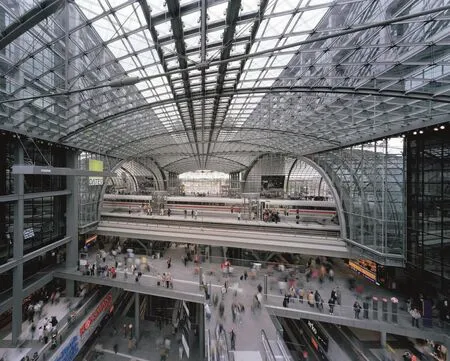
7 中央大厅内景/Interior view, central hall
The cruciform train station rests on a building base, which simultaneously integrates the dominant, diagonal building bars. The rectangular base is accessible on all four sides via stair links and offers open public spaces at a height of 4.43 m above street level, which are clearly separated from the circulation zones. From an urban planning aspect,the building parts accommodated in the base serve to integrate the cruciform hall ensemble and the urban district. Simultaneously it adds further usesto the train station complex, giving an important impetus to the overall urban district. Service and delivery functions are located in the base element on the eastern and western sides. Large areas for shops are found primarily on levels – 1 and ±0 in the western part. Railway-specific uses are located on the mezzanine –1/2. The control point of Berlin's Central Station is also to be found in this location.
The arch buildings
Two 46-m-high building bars bridge the east west railway track, with the lattice structure of the façade reflecting the lightweight appearance of the glass station halls. The supporting steel structure of the building bars is visibly positioned in front of the façade level, consequently defining the character of the north-south station hall. The external façade of the building bars forms an architectural unity with the train station hall by serving as a joint external wall on levels ±0 to +4. In the area of the urban railway bridge, a cantilevered building structure stretches over 87 m on levels +7 to +10. Load transfer for the bridge element is provided via an external steel framework across the complete bridge height, integrating external columns and beams.
After its completion in 2006, Berlin Central Station as Europe's largest intersection train station serves as important transport centre in immediate proximity to the government district, and simultaneously presents a lively building complex thanks to its mixed use with commercial areas and offices, integrating the various surrounding urban environments.□

8-11 中央大厅内景/Interior views, central hall
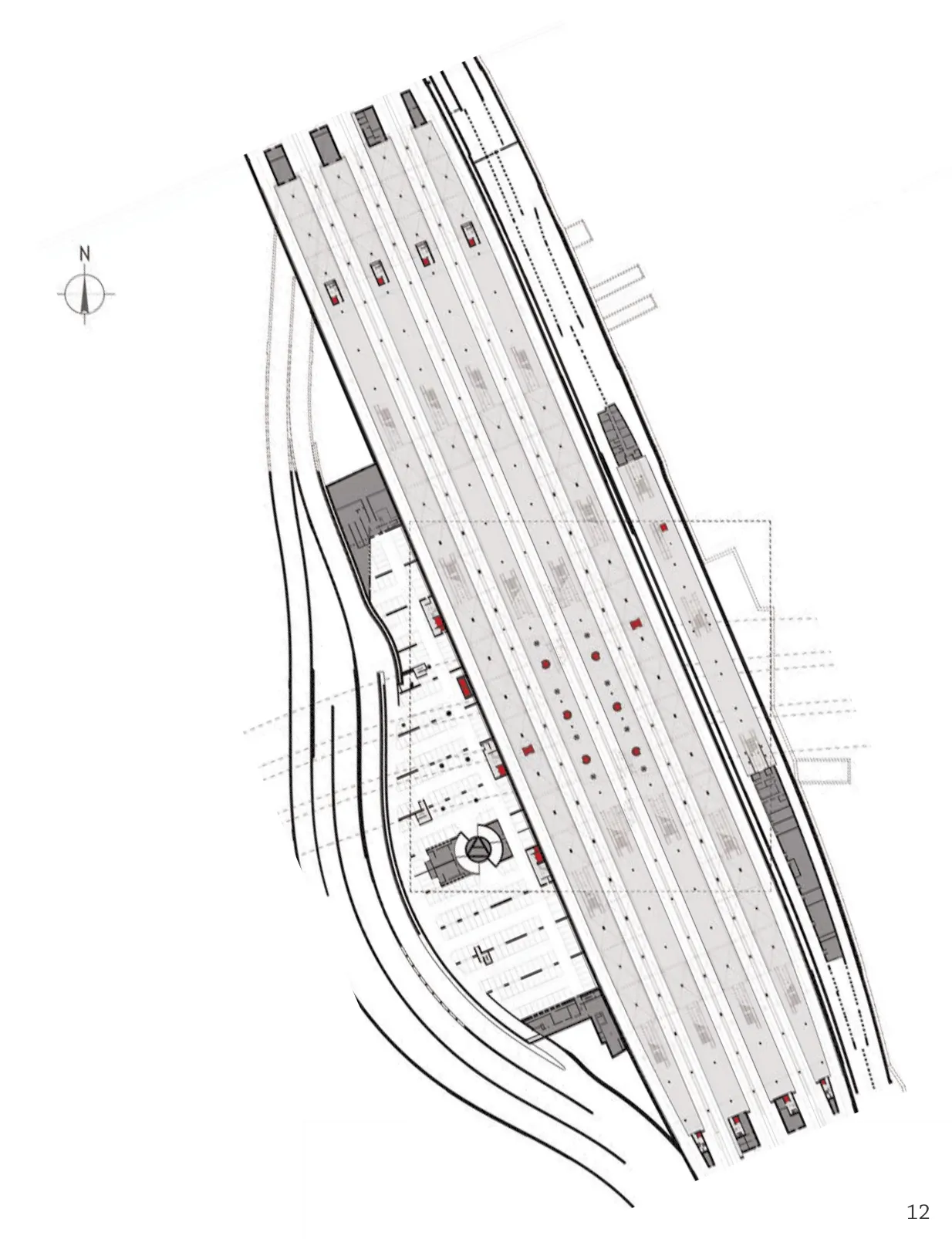
12 地下2层平面/Floor -2 plan

13 地下1层平面/Floor -1 plan

14 首层平面/Ground fl oor plan
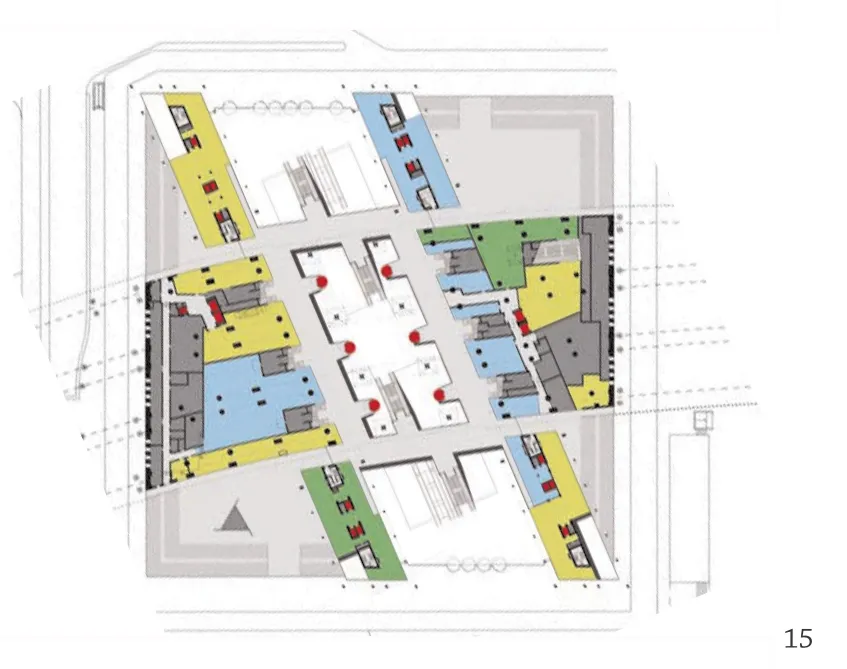
15 1.5层平面/0.5 fl oor plan
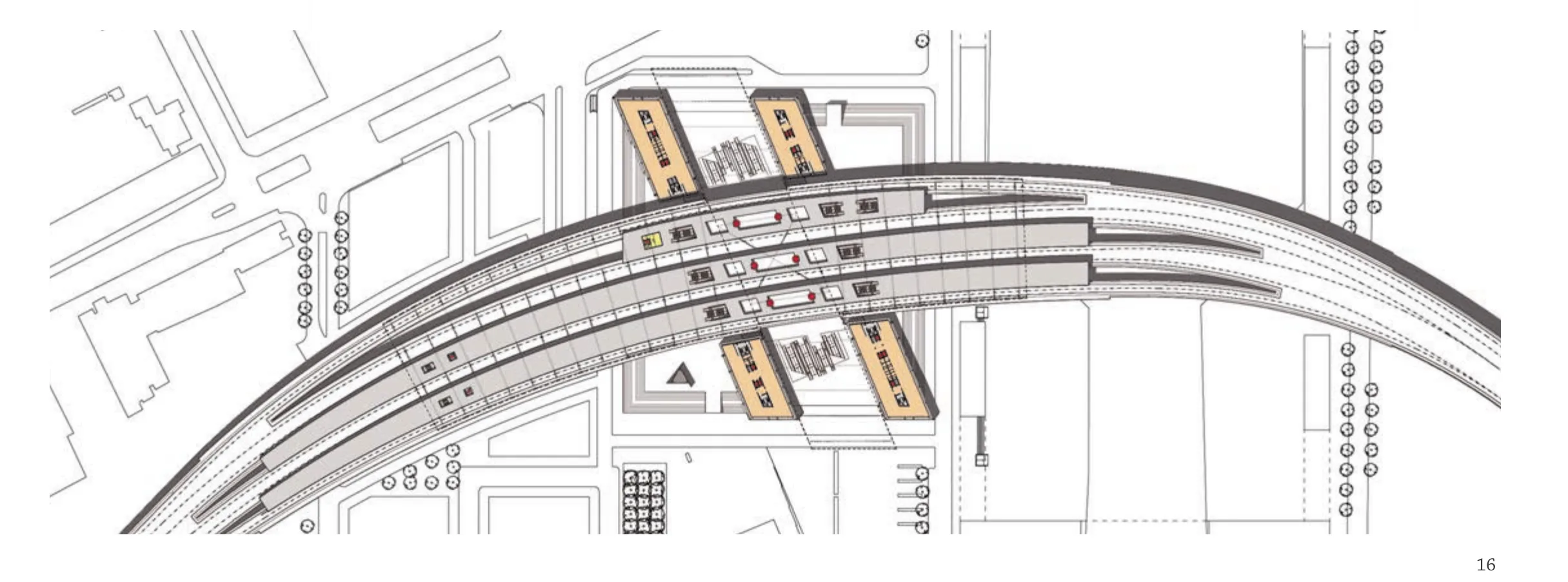
16 二层平面/1st fl oor plan
评论
王江燕:柏林中央火车站是欧洲最大的包括了远程、区域和市内交通的枢纽型火车站,建成于2006年。每个使用过它的乘客和到车站休闲旅游、吃饭购物的游客都会对它紧凑集约的交通枢纽布局、便捷的换乘、为周边景观锦上添花的建筑设计和车站的综合商业、办公功能留下深刻的印象。5层的中心大厅和东西侧玻璃大厅界定了明确的长短途交通功能,十字交叉的换乘安排造就了便捷舒适的换乘环境。虽然它是一座火车站,但却成为柏林的必游之地。因此,柏林中心火车站不仅是一座交通枢纽,也只一个建筑杰作和成功的以公交为先导的开发范例。
王睦:柏林中央车站为欧洲最大、最现代化的火车站,坐落在城市中心地带——东西德昔日的边界上,既成为德国统一的鲜明象征,更重要的是由于车站位于欧洲高铁网的核心,强化了柏林稳坐新欧洲的中心位置,并向全世界展现德国的国家形象。
车站设计注重考虑与城市中心区的远期发展和区域整体性相匹配:通过简洁、坚定又不失轻盈的方正玻璃整体外观塑造出现代感十足的印象,与施普雷河(护城河)对面的国会大厦遥相呼应,并与不远处的地标勃兰登堡门形成市中心的三大标志性建筑;车站46m的高度与国会大厦从穹顶到地面47m的高度保持协调;为适应城市中心区紧张的用地条件,特意将铁路地下化,并通过车站一层大厅将南北向空间连接起来;车站体量虽大,但由于大量使用玻璃和金属的材料、结构,化整为零的体量处理手法,使整个车站显得轻盈通透,既保证了自身的形象突出,又不至于显得过于突兀;沿站台方向使用拱形的玻璃雨棚,两座横跨于站台上的办公塔楼暗示了位于地下的火车的运行方向,也增加了火车站的可识别性。
车站场地设计分为三个部分:北广场、台阶基座及南广场。空间组织十分集约,缩短与城市其他建筑的距离。其中,4.43m高的台阶基座直接与车站的二层连接,既增加了车站的体量感,又形成了周边建筑到车站的过渡,并作为车站露天功能区,增添了车站的城市门户形象。
在竖向功能布局上,柏林站采用了典型的“三明治”结构,地上三层和地下二层主要为车站对外的轨道交通设施层,地下一层至地上二层为车站配套的商业服务区域。以交通换乘动线串接所有的商业空间,极大地提高了商业空间的商业价值。
Comments
WANG Jiangyan: Berlin Central Station, built in 2006, is the largest railway station hub in Europe, which includes long-distance, regional and city transport services. Every passenger who has used it and tourist who has been to the station for leisure, travel, eating and shopping would be deeply impressed by its compact and intensive transportation hub layout, convenient transfer, architectural design that added beauty to the surrounding landscape,and the comprehensive business and office functions of the station. The central hall on the fifth floor and the glass halls on the west and east sides define the clear function of long and short distance transport, and the crossing transfer arrangement creates a convenient and comfortable transfer environment. Although it is a railway station, it has become a must-go destination in Berlin. Therefore, the Berlin Central Station is not only a transportation hub, but also an architectural masterpiece and a successful example of transit-oriented development. (Translated by CHEN Yuxiao)
WANG Mu: Berlin Central Station is the biggest, most modern train station in Europe. It's located at the city central area, the former border between DDR and BRD. Not only did it become a distinctive symbol of Germany's unification,but more importantly, sitting at the core of European highspeed rail network, it also strengthened the central position of Berlin in the new Europe and presented the German national image to the whole world.
The design of the station laid emphasis on matching it with the long-term development of the city central and the integrity of region: forming a very modern image with the simple, firm but also light cubic glass appearance, responding to the Parliament House across Spree River (moat), and making up the three iconic landmarks in the city centre together with Brandenburger Tor not far away; keeping coordination to the 47m height of the Parliament House from top of the dome to the ground with the 46m height of the station; intentionally making the railway underground and connecting the North-South space with the hall on the first floor of the station to adapt to the intensive land use condition in the city central area; making the whole station look light and transparent by the large usage of glass and metal material and structure, and the volume treatment of breaking into pieces, although the station is massive, which kept the figure to be outstanding but not too abrupt; using vaulted glass canopy along the side of the platforms and implying the train moving direction underground with the two office tower buildings across the platforms which also enhanced the identity of the train station.
The site design of the station is divided into three parts: the north square, the step foundation and the south square. The space organisation is very intensive,which shortens its distance from other buildings in the city. The 4.43m high step foundation is directly connected to the second floor of the station. It not only increases the sense of weight of the station, but also forms the transition from the surrounding buildings to the station.As a layout area for the outdoor functions of the station,it also adds to the frontal image of the station in the city.
In terms of vertical functional layout, the Berlin Station has adopted the typical sandwich structure:the levels of 3F and B2 are mainly the external rail transportation facilities of the station and from B1 to 2F are the commercial service areas matching to the station.Linking all the commercial space with transportation transfer route greatly enhanced the commercial value of commercial space. (Translated by CHEN Yuxiao)
项目信息/Credits and Data
业主/Client: 德国铁路股份有限公司/Deutsche Bahn AG represented by DB ProjektVerkehrsbau GmbH
主持建筑师/Principal Architects: 迈因哈德·冯-格康,于尔根·希尔默/Meinhard von Gerkan, Jürgen Hillmer
铁路项目负责人/Project Managers, Long-Distance Rail:Hans-Joachim Glahn, Klaus Hoyer
玻璃屋面项目负责人/Project Manager, Glass Roofs: Prisca Marschner
U型建筑项目负责人/Project Manager, Building Slabs:Prisca Marschner, Susanne Winter
结构设计/Structural Engineering: SchlaichBergermann und Partner, IVZ/Emch+Berger
照明设计/Lighting Design: Peter Andres + Conceptlicht GmbH
建筑设备/Technical Building Equipment: Brandi IGH
建筑面积/Gross Floor Area: 175,000m2(5个交通层/5
transportation levels)
东西向玻璃屋面长度/Length of Glass Roof: 321m
玻璃屋面宽度/Width of Glass Roof: 59~68m
玻璃屋面高度/Hight of Glass Roof: 自站台标高算起15~17m/15~17m from platform
基地面积/Site Area: 100,000m2
建设周期/Construction Period: 1996-2006
摄影/Photos: Marcus Bredt

17.18 剖面/Sections
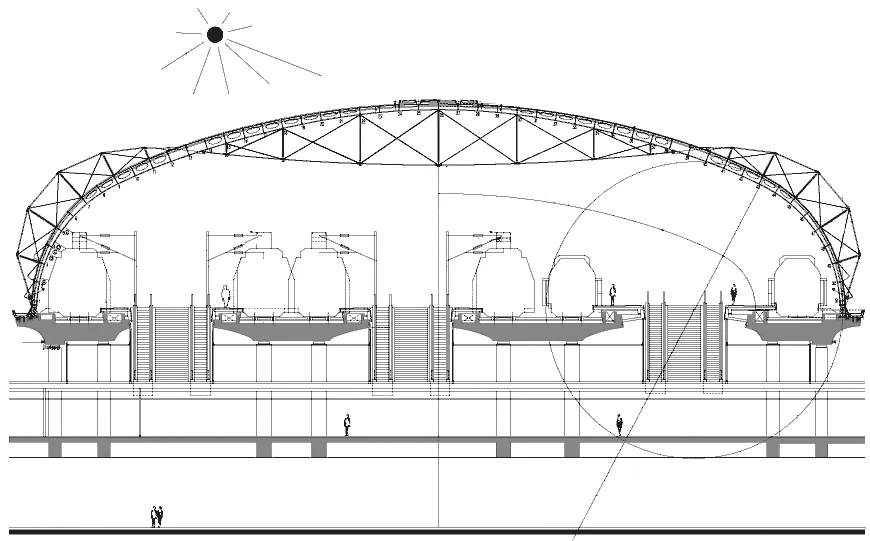
19 横剖面/Cross section

